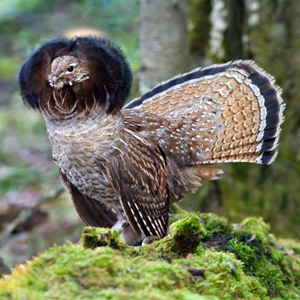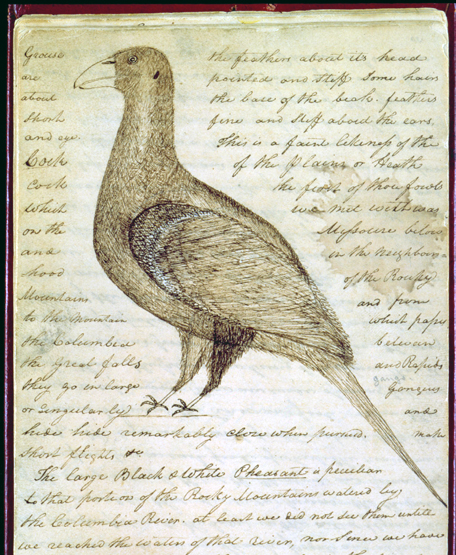Lewis’s Three Pheasants
Sage Grouse, Centrocercus urophasianus[1]Centrocercus urophasianus is pronounced sen-tro-SER-kus YOU-row-faze-ee-AY-nus. The name of the genus is a combination of the Greek kentron, meaning point, and kerkos, tail. The specific epithet is … Continue reading
“Cock of the Plains”
Drawing by William Clark, 2 March 1806. Missouri Historical Society, Voorhis Collection, No. 2.
On 20 September 1805, on the day his party camped at is now known as Pheasant Camp, Lewis described three types of grouse:
Three species of Pheasants, a large black species, with some white feathers irregularly scattered on the brest neck and belley [blue grouse] a smaller kind of a dark uniform colour with a red stripe above the eye [spruce grouse], and a brown and yellow that a good deel resembles the phesant common to the Atlantic States [Oregon ruffed grouse].
Noah Webster, in 1806, defined the word pheasant as “a genus of gallinaceous birds,” and gallinaceous as a reference to “domestic fowls, or the gallinae”—the latter from the Latin gallus, meaning a cock or rooster. He defined grouse as “a fine kind of bird found on heaths,” a heath as “common ground,” and a common as “land belonging to a number [of persons] and not divided or separated by fences.” A heathcock was “a kind of fowl upon heaths, the grous.”[2]Noah Webster, A Compendious Dictionary of the English Language (1806; facsimile reprint, New York: Crown Publishers, 1970). A fowl was, and still is, any bird of the order Galliformes, which includes not only of the domestic chicken, and turkey, but also the wild pheasant and grouse. Now that we have gotten inside Lewis’s mind through these words, we are equipped to understand why he referred to some grouse as pheasants.
Grouse in the Journals
The word grouse first appeared in the journals on 22 November 1803, near Tywapppity on the Mississippi, when Lewis writes “saw some Heth hens or grows.” On 15 December 1803, at the site of Camp Dubois, Clark notes “hunters [k]illed Some grouse.” The next reference is at White Catfish Camp on 25 July 1804: Clark writes “Several Grous Seen to day.” In northeastern Montana on 15 April 1805, Lewis wrote:
met with great numbers of Grouse or prarie hens as they are called by the English traders of the N.W.[3]The “English traders of the N.W.” would have been the men of the North West Company at Fort Assiniboine in Canada, such as Charles McKenzie and François-Antoine Larocque, whom Lewis met … Continue reading these birds appeared to be mating; the note of the male is kuck, kuck, kuck, coo, coo, coo. the first part of the note both male and female use when flying. the male also dubbs [drums with his wings] something like the pheasant, but by no means as loud.
It is probable that he had observed some sharp-tailed grouse, Tympanuchus phasianellus (tim-pan-oo-kuss faze-ee-an-nell-us; “drumming pheasant”), and compared them with the bird we now call the ruffed grouse, but which he knew only as the “common pheasant”—though the New Englanders in the company, such as Alex Willard, might have called them “partridges.”
Lewis invoked the word grouse just one more time—in his description of the bird later called the Columbian sharp-tail, which he wrote at Fort Clatsop on 1 March 1806: “The Grouse or Prarie hen is peculiarly the inhabitant of the Great Plains of Columbia”—or, as Clark reworded it, “The Prarie Hen sometimes called the Grouse.” Prarie hen and cock of the plains were appropriate alternatives to heathcock, prairie and plains being more descriptive of the broad Northwestern flatlands than heath. When it came to the three new gallinae of the Rocky Mountains, however, Lewis resorted to merely listing the new birds’ resemblances and contrasts with “the common pheasant.” One more new member of the family Phasianidae that Lewis discovered was the bird he called the “cock of the plains,” now called sage grouse. In the field, Lewis drew upon his intimate acquaintance with his own woodlands and their inhabitants, as the basis for much of his analysis of new species.
Confused Identity
Up to this point, we have merely addressed the first problem in our consideration of Lewis’s choice of a genus. Now we come to the critical problem, the understanding of Lewis’s various attempts to identify the species he believed he had found. As Elliott Cous (pronounced cowz) pointed out in his commentary on Biddle’s paraphrase of the journals, “No descriptions in L. and C. have teased naturalists more than those here given of the three ‘pheasants.’ As they stand in the text, they are an odd jumble, utterly irreconcilable with what we know of these birds.”[4]Elliott Coues, ed., The History of the Lewis and Clark Expedition by Meriwether Lewis and William Clark (Reprint, 1893. 3 vols., New York: Dover, 1965), 870-72. Confusion has persisted since Cous wrote that in 1893, so, at the expense of historical accuracy and insight, we will reduce those murky taxonomic intricacies into a menu of more easily digestible gallinaceous viands.
The Real Pheasant
The real cause of our confusion over Lewis’s nomenclature is that the word pheasant now brings to mind an exotically colored Asian bird otherwise known as the ring-necked pheasant, a member of the family Phasianidae (fay-see-ahn-ih-dee), from Phasis, the ancient name of the Rion River in the Republic of Georgia, on the Black Sea in the Middle East. The first few Phasianidae, also known as “Chinese” pheasants (Phasianus colchicus; fay-sih-ay-nus col-kih-kus);[5]Grzimek’s Animal Life Encyclopedia, 7:432-33. were introduced into California in 1857, and larger numbers were brought to Oregon in the 1880s. Since then, no other bird except the domestic chicken—believed to have been brought to America by Christopher Columbus—has been so widely carried all over the world since Odysseus took some back to Greece from the shores of the Phasis. By the beginning of the 20th century the ring-necks had definitively monopolized the name pheasant. Soon the name grouse defaulted to the three new species—except in some northeastern rural areas where “partridge,” and sometimes “common quail,” have continued in favor, and in the southern Appalachians, where a ruffed grouse is still, to some people, a “pheasant.”
Encountered Species


At Fort Clatsop on 5 February 1806, Reubin Field returned from a hunt with “a phesant which differed but little from those common to the Atlantic states.”


“The Heath Cock or cock of the Plains is found in the Plains of Columbia and are in great abundance from the enterance of Lewis’s river to the mountains which pass the Columbia between the Great falls and Rapids of that river.” Thus we have a historic account of sage grouse range and abundance.


What is most remarkable about Meriwether Lewis’s work as a naturalist is that he observed and wrote so much about the plants and animals he saw. An unusual example is his description of the bird now commonly known as the spruce grouse.


Elliott Coues, whose scientific interest centered on ornithology, in 1893 declared Lewis’s “Grouse or Prarie hen” to be the Oregon ruffed grouse, at that time classified as Bonasa umbellus sabinei (Ord) Coues.


“this bird is fully a third larger than the common phesant of the Atlantic states. it’s form is much the same. it is booted nearly to the toes and the male has not the tufts of long black feathers on the sides of the neck which are so conspicuous in those of the Atlantic.”
Notes
| ↑1 | Centrocercus urophasianus is pronounced sen-tro-SER-kus YOU-row-faze-ee-AY-nus. The name of the genus is a combination of the Greek kentron, meaning point, and kerkos, tail. The specific epithet is from another Greek word for tail, oura, plus phasianos, pheasant. The noun pheasant was originally applied to a bird that was native to the valley of the Phasis River (now the Rioni River), which drains into the Black Sea from the Repubic of Georgia. In the time of Lewis and Clark the word pheasant stood for “a genus of gallinaceous birds,” according to lexicographer Noah Webster (1806), and the explorers often used it in that sense. Gallinaceous then referred to “domestic fowls, or the gallinae”; the family Galliformes (Latin gallus, cock, and forma, shape) now includes pheasants, grouse, turkeys, quail, and all domestic chickens. Lewis and Clark are credited with the discovery of five gallinaceous birds in addition to the sage grouse: the Columbian sharp-tailed grouse, the dusky grouse, Franklin’s grouse, the Oregon ruffed grouse, and the mountain quail. The taxonomy of the sage grouse was written in 1827 by the biologist Charles Lucien Bonaparte (1803-1857), a nephew of Napoleon. Paul Russell Cutright, Lewis & Clark, Pioneering Naturalists (Lincoln: University of Nebraska Press, 1969), 157, 388; Raymond Burroughs, ed., The Natural History of the Lewis and Clark Expedition (paperback ed., with an introduction by Robert Carriker, East Lansing: Michigan State University Press, 1995), 211-15. |
|---|---|
| ↑2 | Noah Webster, A Compendious Dictionary of the English Language (1806; facsimile reprint, New York: Crown Publishers, 1970). |
| ↑3 | The “English traders of the N.W.” would have been the men of the North West Company at Fort Assiniboine in Canada, such as Charles McKenzie and François-Antoine Larocque, whom Lewis met at Fort Mandan in the winter of 1804-05. See also Larocque at Fort Mandan. |
| ↑4 | Elliott Coues, ed., The History of the Lewis and Clark Expedition by Meriwether Lewis and William Clark (Reprint, 1893. 3 vols., New York: Dover, 1965), 870-72. |
| ↑5 | Grzimek’s Animal Life Encyclopedia, 7:432-33. |
Experience the Lewis and Clark Trail
The Lewis and Clark Trail Experience—our sister site at lewisandclark.travel—connects the world to people and places on the Lewis and Clark Trail.
Discover More
- The Lewis and Clark Expedition: Day by Day by Gary E. Moulton (University of Nebraska Press, 2018). The story in prose, 14 May 1804–23 September 1806.
- The Lewis and Clark Journals: An American Epic of Discovery (abridged) by Gary E. Moulton (University of Nebraska Press, 2003). Selected journal excerpts, 14 May 1804–23 September 1806.
- The Lewis and Clark Journals. by Gary E. Moulton (University of Nebraska Press, 1983–2001). The complete story in 13 volumes.



